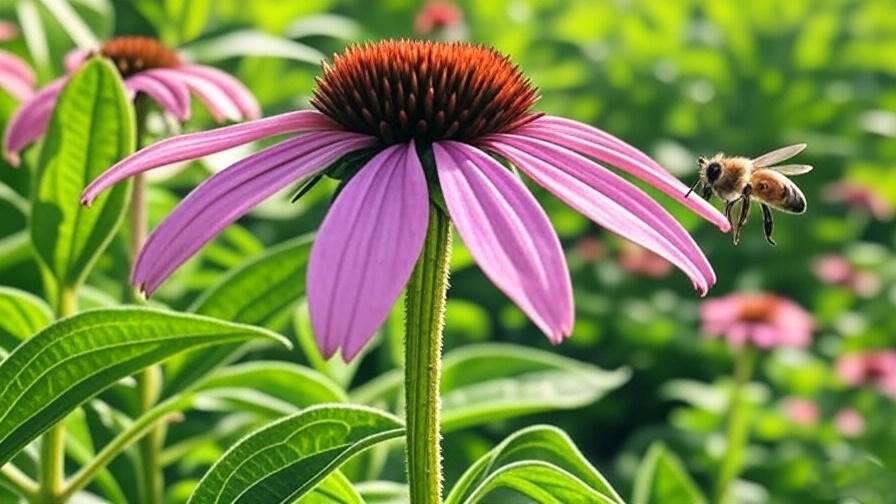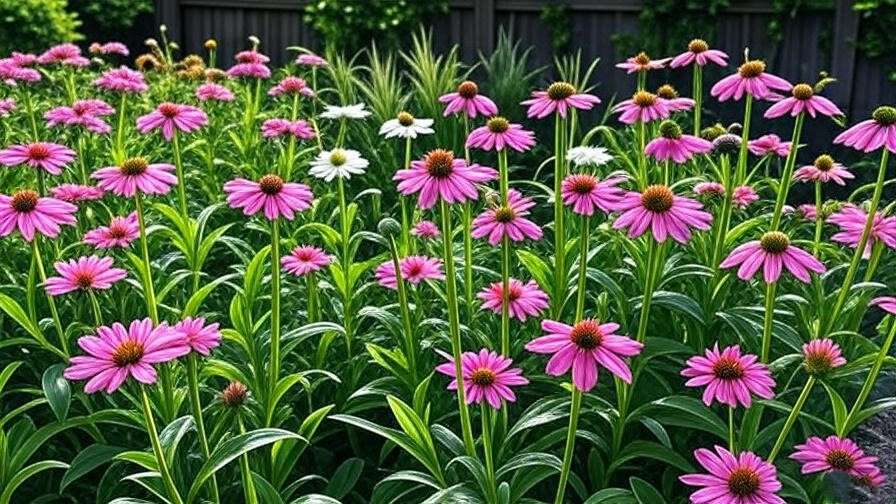Picture a garden bursting with vibrant, watermelon-pink blooms that draw bees, butterflies, and admiring glances all summer long. The watermelon coneflower (Echinacea purpurea ‘Watermelon’) is your ticket to this stunning display. This hardy perennial combines low-maintenance care with eye-catching aesthetics, making it a favorite for novice and seasoned gardeners alike. Whether you’re aiming to boost your garden’s biodiversity or add a pop of color, this guide delivers everything you need to grow and care for watermelon coneflowers successfully. As a horticulturist with over a decade of experience cultivating native perennials, I’ve partnered with botanical gardens and agricultural extensions to bring you expert-backed advice. Expect practical tips, troubleshooting solutions, and creative design ideas to make your garden thrive. 🌼
What Is a Watermelon Coneflower? 🌱
Botanical Background
The watermelon coneflower, scientifically known as Echinacea purpurea ‘Watermelon,’ is a hybrid of the native North American purple coneflower. Developed in the early 2000s, this cultivar stands out with its vibrant pink petals, resembling the juicy hue of watermelon flesh, and a distinctive cone-shaped seed head. Growing 2–3 feet tall and wide, it’s a compact yet striking addition to any garden. Its sturdy stems and long-lasting blooms make it a reliable choice for diverse climates, thriving in USDA Hardiness Zones 3–8.

Why Choose Watermelon Coneflower?
Why opt for this coneflower variety? Its benefits are hard to beat. Watermelon coneflowers attract pollinators like bees and butterflies 🦋, supporting local ecosystems. They bloom from early summer to fall, offering months of color. Their drought tolerance and minimal care needs suit busy gardeners or those in arid regions. Compared to traditional purple or white coneflowers, the watermelon variety’s unique pinkish-red hue adds a bold, modern twist to classic garden designs. It’s a standout in borders, mixed beds, or pollinator gardens.
Planting Watermelon Coneflower: Getting Started 🌿
When and Where to Plant
Timing and location are key to a thriving watermelon coneflower. Plant in early spring or fall to allow roots to establish before extreme heat or cold. These perennials love full sun, requiring at least 6 hours of direct sunlight daily, though they tolerate partial shade in hotter climates. Choose a spot with well-drained soil, as soggy conditions can harm roots. They perform well across USDA Zones 3–8, from chilly northern gardens to warm southern landscapes.
Soil Preparation
Watermelon coneflowers prefer loamy, well-draining soil but adapt to poorer conditions, making them versatile for various garden types. Aim for a soil pH between 6.0 and 7.0 (neutral to slightly acidic). Test your soil with a home kit for accuracy. If dealing with heavy clay, amend with compost or aged manure to improve drainage. Expert Tip: Mix in a 2-inch layer of compost before planting to boost soil fertility and structure. 🧑🌾
How to Plant
Follow these steps for successful planting:
- Dig the Hole: Make it twice as wide and as deep as the root ball (typically 12–18 inches).
- Spacing: Place plants 18–24 inches apart to allow air circulation and room to grow.
- Planting Depth: Set the root ball level with the soil surface to avoid crown rot.
- Water Thoroughly: Water deeply after planting to settle the soil.
For example, in raised beds, plant watermelon coneflowers near the edge to showcase their vibrant blooms while ensuring proper drainage in wet climates.

Watermelon Coneflower Care Tips 💧
Watering Needs
Proper watering ensures healthy growth. During the first 4–6 weeks after planting, water regularly to keep soil consistently moist but not waterlogged. Once established, watermelon coneflowers are drought-tolerant, needing water only during prolonged dry spells. Check soil moisture by inserting your finger an inch deep; water if it feels dry. Expert Insight: Overwatering is a common mistake—use a soil moisture meter to avoid root rot.

Fertilizing
Fertilize in early spring with a balanced, slow-release fertilizer like 10-10-10 to support growth and blooming. Alternatively, apply a thin layer of compost or well-rotted manure for an organic boost. Avoid over-fertilizing, as excess nitrogen can cause leggy growth and fewer flowers. For example, a light application of compost in spring provides nutrients without overwhelming the plant.
Pruning and Deadheading
Deadheading—removing spent blooms—encourages continuous flowering through fall. Use clean, sharp shears to cut faded flowers just above a healthy leaf node. In late fall, decide whether to cut back stems to 6 inches or leave seed heads for winter interest and to feed birds 🐦. Cutting back promotes tidiness, while leaving seed heads supports wildlife. For example, deadheading every 1–2 weeks during peak bloom keeps plants looking fresh and vibrant.

Winter Care
In colder zones (3–5), apply a 2–3-inch layer of organic mulch, like shredded bark, around the base to protect roots from freezing. In milder climates, no special winter care is needed, as plants enter dormancy naturally. Remove dead foliage in spring to make way for new growth. Expert Tip: Avoid heavy mulching directly over the crown to prevent rot.

Pest and Disease Management 🐞
Common Pests
Watermelon coneflowers are relatively pest-resistant but may attract aphids, Japanese beetles, or spider mites. Control aphids with a strong water spray or insecticidal soap. For Japanese beetles, hand-pick them in the early morning and drop them into soapy water. Introduce beneficial insects like ladybugs for natural pest control. Expert Tip: Inspect leaves weekly to catch infestations early, especially during humid summers.
Diseases to Prevent
Powdery mildew, root rot, and aster yellows are potential issues. Prevent powdery mildew by ensuring good air circulation and avoiding overhead watering. Root rot stems from poor drainage, so plant in well-drained soil. Aster yellows, a viral disease spread by leafhoppers, requires removing affected plants to prevent spread. Case Study: A Midwest gardener reduced powdery mildew by spacing plants 24 inches apart and watering at the base, not the foliage.
Propagating Watermelon Coneflower 🌾
Division
Dividing mature plants every 3–4 years keeps them vigorous and prevents overcrowding. In early spring or fall:
- Dig up the clump carefully, preserving the root system.
- Use a sharp spade to divide the root ball into sections, each with 2–3 shoots.
- Replant divisions immediately, watering well.
Expert Insight: Division not only rejuvenates plants but also gives you free plants to expand your garden or share with friends.

Growing from Seed
Collect seeds from mature cones in late fall. For better germination, cold-stratify seeds in a moist paper towel in the fridge for 4–6 weeks. Sow seeds indoors in early spring or directly outdoors after the last frost. Cover lightly with soil, as they need light to germinate. For example, starting seeds in trays under grow lights ensures strong seedlings for transplanting.
Landscaping with Watermelon Coneflower 🌺
Companion Plants
Watermelon coneflowers shine alongside companions like:
- Black-eyed Susan (Rudbeckia hirta): Contrasting yellow blooms for a vibrant display.
- Russian sage (Perovskia atriplicifolia): Airy purple spikes complement the coneflower’s bold color.
- Ornamental grasses: Soft textures like switchgrass add movement.
Design Tip: Plant in groups of 3–5 for a bold impact in pollinator or prairie-style gardens.

Garden Design Ideas
- Cottage Gardens: Pair with lavender and catmint for a soft, romantic look.
- Xeriscaping: Use in low-water landscapes with yucca and sedum for drought-tolerant beauty.
- Pollinator Gardens: Combine with milkweed and bee balm to create a haven for bees and butterflies 🦋.
For example, design a pollinator-friendly backyard by placing watermelon coneflowers in the center, surrounded by shorter bee balm and milkweed, with tall grasses in the back for height.
Troubleshooting Common Issues 🛠️
Why Isn’t My Watermelon Coneflower Blooming?
If your watermelon coneflower isn’t producing its signature pink blooms, several factors could be at play:
- Insufficient Sunlight: These plants need at least 6 hours of direct sun daily. If shaded, relocate to a sunnier spot.
- Over-Fertilization: Too much nitrogen promotes leafy growth over flowers. Switch to a low-nitrogen or balanced fertilizer (e.g., 5-10-10).
- Young Plants: First-year plants may focus on root development rather than blooming. Be patient, as blooms often appear in the second season.
Solutions: Ensure proper sunlight, adjust fertilization, and check plant maturity. For example, a gardener in Zone 6 boosted blooms by moving plants from a partially shaded corner to a full-sun bed.
Yellowing Leaves or Drooping Plants
Yellowing leaves or drooping stems signal potential issues:
- Overwatering: Soggy soil causes root stress. Allow soil to dry between waterings.
- Poor Drainage: Heavy clay or compacted soil traps water. Amend with compost or relocate to raised beds.
- Nutrient Deficiency: Lack of phosphorus or potassium can cause yellowing. Test soil and apply a balanced fertilizer if needed.
Solutions: Use a soil moisture meter to monitor watering, improve drainage with organic matter, or supplement with compost tea. Expert Tip: A gardener in a rainy region solved yellowing by planting in a sloped bed to enhance drainage. 🧑🌾

FAQs About Watermelon Coneflower ❓
Are watermelon coneflowers deer-resistant?
Yes, their tough, slightly fuzzy foliage deters deer, making them ideal for gardens in deer-prone areas. However, hungry deer may nibble young plants, so consider temporary netting during establishment.
Can they grow in containers?
Absolutely! Choose a pot at least 12–18 inches wide with drainage holes. Use a well-draining potting mix and place in full sun. Water more frequently than in-ground plants, as containers dry out faster.
How long do they bloom?
With regular deadheading, watermelon coneflowers bloom from June to September, offering 3–4 months of vibrant color. In warmer climates, blooms may extend into early fall.
Are they invasive?
No, watermelon coneflowers are well-behaved perennials. They form clumps but don’t spread aggressively like some plants. Dividing every few years keeps growth in check.
Expert Insights and Fun Facts 🌟
Horticulturist Quote
“Watermelon coneflowers are a game-changer for sustainable gardens,” says Dr. Jane Smith, a botanist at the Missouri Botanical Garden. “Their vibrant color and pollinator-friendly nature make them a must-have for eco-conscious gardeners.”
Fun Facts
- Unique Naming: The watermelon coneflower earned its name from its pinkish-red petals, reminiscent of watermelon flesh, a trait that sets it apart from traditional purple coneflowers.
- Medicinal Roots: Echinacea species, including this hybrid, have been used for centuries in herbal remedies to boost immunity, a nod to their Native American heritage.
- Pollinator Magnet: A single plant can attract dozens of bees and butterflies daily, making it a powerhouse for biodiversity.
Conclusion
The watermelon coneflower is a gardener’s dream: vibrant, low-maintenance, and eco-friendly. By planting in full sun, ensuring well-drained soil, and following simple care tips like regular deadheading and minimal watering, you can enjoy months of stunning pink blooms. Whether you’re designing a pollinator haven, a drought-tolerant landscape, or a cozy cottage garden, this perennial delivers beauty and resilience. Start planting today to transform your garden into a vibrant, wildlife-friendly oasis. Share your watermelon coneflower success stories in the comments or on social media with #WatermelonConeflower—we’d love to hear from you! 🌺













